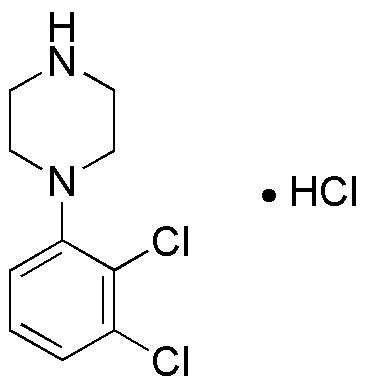1-(2,3-dichlorophenyl)piperazine hydrochloride is widely utilized in research focused on:
- Pharmaceutical Development: This compound serves as a key intermediate in the synthesis of various pharmaceuticals, particularly in the development of antipsychotic and antidepressant medications, enhancing therapeutic options for mental health disorders.
- Neuroscience Research: It is used in studies examining neurotransmitter systems, providing insights into brain function and the mechanisms of psychiatric conditions, which can lead to improved treatment strategies.
- Analytical Chemistry: The compound is employed in analytical methods to detect and quantify piperazine derivatives in biological samples, aiding in pharmacokinetic studies and drug monitoring.
- Material Science: Researchers explore its potential in developing novel materials with specific electronic or optical properties, contributing to advancements in technology and materials engineering.
- Environmental Studies: It is investigated for its behavior and degradation in environmental settings, helping to assess the impact of pharmaceutical pollutants and inform regulatory practices.
General Information
Properties
Safety and Regulations
Applications
1-(2,3-dichlorophenyl)piperazine hydrochloride is widely utilized in research focused on:
- Pharmaceutical Development: This compound serves as a key intermediate in the synthesis of various pharmaceuticals, particularly in the development of antipsychotic and antidepressant medications, enhancing therapeutic options for mental health disorders.
- Neuroscience Research: It is used in studies examining neurotransmitter systems, providing insights into brain function and the mechanisms of psychiatric conditions, which can lead to improved treatment strategies.
- Analytical Chemistry: The compound is employed in analytical methods to detect and quantify piperazine derivatives in biological samples, aiding in pharmacokinetic studies and drug monitoring.
- Material Science: Researchers explore its potential in developing novel materials with specific electronic or optical properties, contributing to advancements in technology and materials engineering.
- Environmental Studies: It is investigated for its behavior and degradation in environmental settings, helping to assess the impact of pharmaceutical pollutants and inform regulatory practices.
Documents
Safety Data Sheets (SDS)
The SDS provides comprehensive safety information on handling, storage, and disposal of the product.
Product Specification (PS)
The PS provides a comprehensive breakdown of the product’s properties, including chemical composition, physical state, purity, and storage requirements. It also details acceptable quality ranges and the product's intended applications.
Certificates of Analysis (COA)
Search for Certificates of Analysis (COA) by entering the products Lot Number. Lot and Batch Numbers can be found on a product’s label following the words ‘Lot’ or ‘Batch’.
*Catalog Number
*Lot Number
Certificates Of Origin (COO)
This COO confirms the country where the product was manufactured, and also details the materials and components used in it and whether it is derived from natural, synthetic, or other specific sources. This certificate may be required for customs, trade, and regulatory compliance.
*Catalog Number
*Lot Number
Safety Data Sheets (SDS)
The SDS provides comprehensive safety information on handling, storage, and disposal of the product.
DownloadProduct Specification (PS)
The PS provides a comprehensive breakdown of the product’s properties, including chemical composition, physical state, purity, and storage requirements. It also details acceptable quality ranges and the product's intended applications.
DownloadCertificates of Analysis (COA)
Search for Certificates of Analysis (COA) by entering the products Lot Number. Lot and Batch Numbers can be found on a product’s label following the words ‘Lot’ or ‘Batch’.
*Catalog Number
*Lot Number
Certificates Of Origin (COO)
This COO confirms the country where the product was manufactured, and also details the materials and components used in it and whether it is derived from natural, synthetic, or other specific sources. This certificate may be required for customs, trade, and regulatory compliance.
*Catalog Number
*Lot Number
Citations
Sign up and save
Entice customers to sign up for your mailing list with discounts or exclusive offers.


